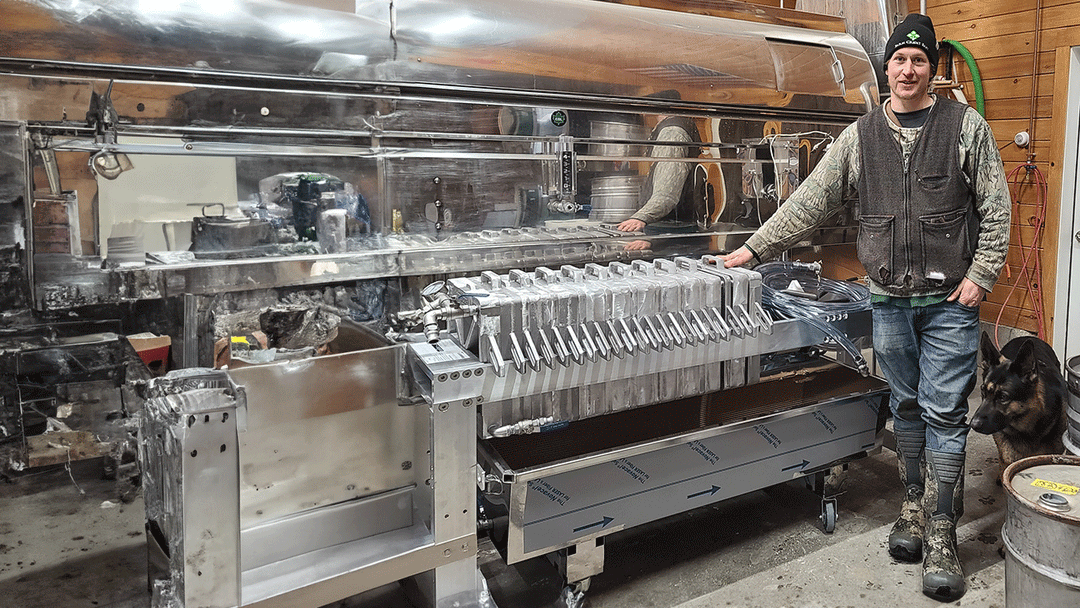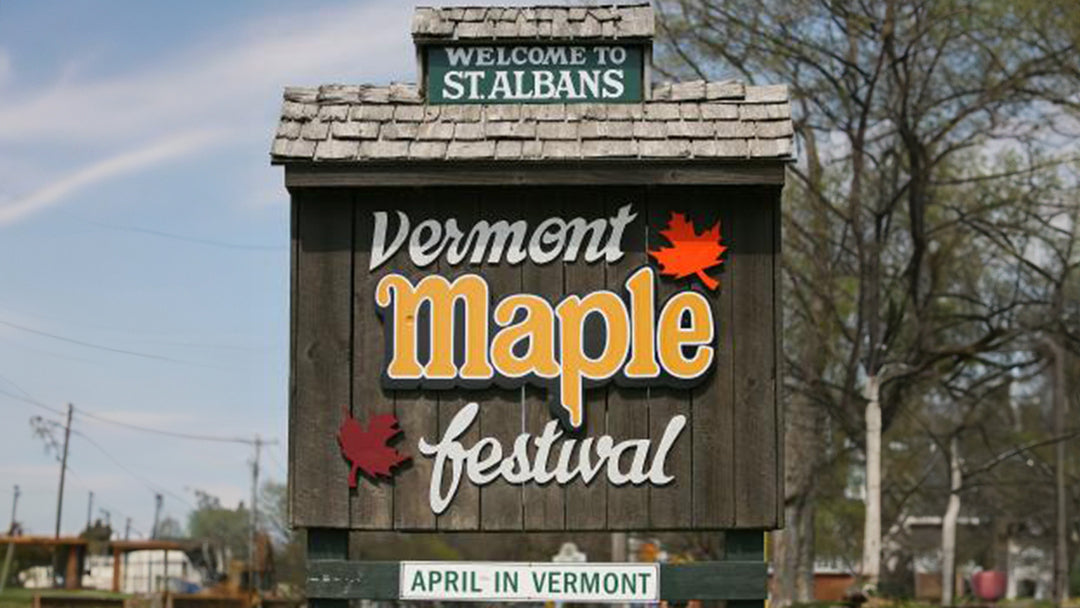How to Tap a Maple Tree
At its most basic, this question can be answered rather simply, during the spring months in the northern hemisphere you drill a hole no deeper than 1.5 inches in a sugar maple tree and collect the sap that runs when temperatures freeze at night and thaw during the day. We could leave it at that, but since you’ve decided to read this far, we’ll go in depth on the physiological processes the trees experience, as well as best practices to ensure you harvest in the most sustainable manner. Also, next time you find yourself at a party (remember those before COVID?) and give the host a gift of maple syrup, you’ll be able to speak deeply on the subject and impress your friends.

Let's take a step back first...
The spring harvest for maple syrup actually begins the summer prior when the leaves of maple trees across the sugarbush are conducting photosynthesis. Turning sunlight, carbon dioxide, and water into carbohydrates, or sugar, as well as oxygen for us all to breathe. One of the special aspects of maple trees, and not the last we’ll mention here, is that they are classified as “shade tolerant”. Shade tolerant trees possess the genetic ability to produce excess energy, or sugar in the form of starch carbohydrates, which they store within the root system and sapwood for later use. In contrast, most trees require as much sun as possible to photosynthesize energy, and consume the results while it's available. The sugars and nutrients stored in sugar maple tree's roots will then be used for bud break and tree growth as spring progresses. Of course, humans have developed a taste for the fruits of the tree's labor as well, but more on that later.
How does sap flow?

Credit: www.sciencelearn.org.nz
The nutrient transportation system of maple trees, precisely designed through thousands of years of evolution is called the vascular system. Within this vascular system, and important to maple sap harvest is the xylem; xylem transports water and nutrients from the soil upwards to the tree extremities. In the summer months the movement of nutrients up the tree is typical of most tree species, whereby the internal pressure produced from photosynthesis pulls fluid from root to leaf. In comparison, and another unique feature of the sugar maple, is it's ability to transport fluid up the xylem during the leafless winter months, when photosynthesis is impossible.
The reason for this unique feature are the tissues surrounding the xylem called ray parenchyma. In most sap producing trees this tissue is filled with water, sugar maples on the other hand have air pockets in this tissue. Essentially, as the upper branches freeze during the cold nights the air in this tissue is compressed through frost formation. The squeezing of air in these pockets behaves similar to a sponge, creating a rapid suction of water from the root system upwards toward the branches. Researching this I was surprised to learn that a gradual freeze throughout the night, starting from the thinnest branches on is preferable, as a quick freeze will block the xylem lower in the tree and prevent water absorption from the roots.
The question you might be asking yourself is how do the sugars mix with the water pulled from the roots? I asked myself the same question. The same ray parenchyma that are filled with air rather than water also contain carbohydrates in the form of starch, created and stored during the summer from photosynthesis. During the spring sap run, as water is pulled upwards in the xylem, enzymes convert the starch to sugar and transmit into the water creating sap. The natural reason for this is to transport nutrients throughout the tree to promote leaf and tree growth for the coming growing season, as we've stated already.

Sustainable Harvest
Throughout the (hopefully!) six weeks or more of the maple season, progressive night time freezes cause internal pressure to build by moving water upwards from the roots. The above freezing temperature releases the sap from outside branches, where the pressure is then relieved through the conveniently placed tap hole drilled just before the harvest season starts. The story should end here right? Should we move on to removing excess water through reverse osmosis, boiling in the evaporator, grading, tasting, and bottling? Well, if you remember, the trees don't produce this sap just for the fun of it. The main purpose (in the trees estimation!) is to provide hormones and energy for growth, bud break, and disease resistance so they enter the coming growing season strong right out of the gate. In order to practice sustainable agriculture year after year, much effort has been expended by researchers and producers alike to develop best practices.
When we first began tapping trees in 1998 the knowledge available was lightyears behind the current times. In our estimation, many sugarmaker harvesting practices were developed through word of mouth, regional industry events, and personal experience. Through much hard work and outreach, University Extension services have developed and distributed the best practices currently in use.

Credit: Mark Isselhardt, UVM Extension
When a tree is tapped, using a 17/64" drill bit at the Carman Brook Farm, what we can call a scar and scientists call non conductive wood is formed. For the life of the tree, this scar will not facilitate the transport of water (think xylem). Therefore, it is imperative to always tap into conductive wood. The size of the scar varies dependent on many factors; however, to prevent damage, University research suggests a 4 inch lateral and 6 inch vertical separation from the prior year's hole. If the tree is able to maintain enough carbohydrates (ensured through sustainable practices) after the sugar season, proper growth rates will push the scar deeper into the tree and not be a factor for future nutrient movement; so long as the sugarmaker makes sure to drill in the conductive wood mentioned above.
How many taps per maple tree?
When we first began harvesting sap from our forest over 20 years ago, there were a ton of different opinions on how many taps a given tree required. Today the recommendation is no more than two, but generally just one. Remember, the intent is to harvest only the sap the tree can spare while also maintaining healthy levels of growth and disease resistance. Most trees are around 40 years old when they first get tapped for their sap. If sustainable harvest practices, such as only tapping fresh conductive wood and limiting taps per tree to no more than two, then UVM research suggests that this tree will be able to be harvested for the next 100 years or more! Generally, at 40 years old the tree is anywhere from 8-12 inches in diameter, we don't add in a second tap unless our tap lines can't reach the entirety of the tree diameter, as well as being robust and healthy enough to support the extra flow. Thankfully, the day's of 3, 4, and sometimes up to 6 taps are in the past, our forests will benefit long into the future.

We believe the maple industry, and Vermont's in particular values the latest sustainable forestry and sap harvesting practices. Carman Brook Farm is no different, it is important to us that the unique ecosystem entrusted to us is handled with the care it deserves, with the least amount of intrusion. Consumers share these values, and it's important that producers are transparent with their practices so that they can make the most informed decision possible regarding where they want to purchase syrup for them and theirs to enjoy. If you have any questions, feel free to drop a comment at the bottom.






Leave a comment